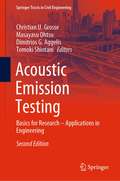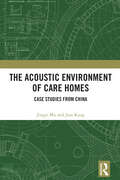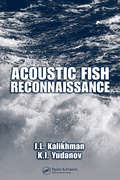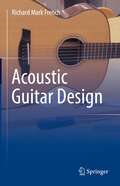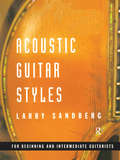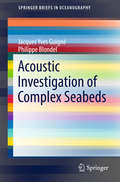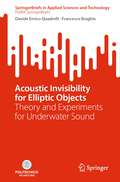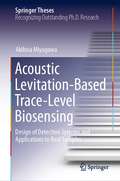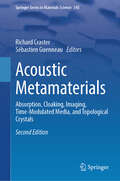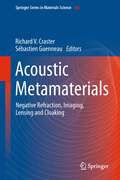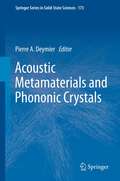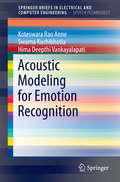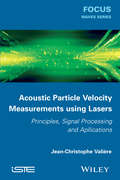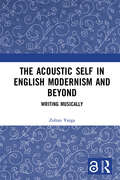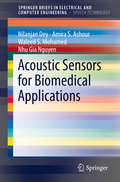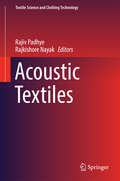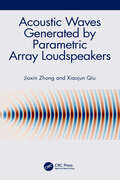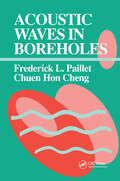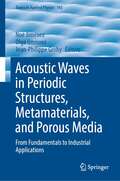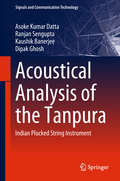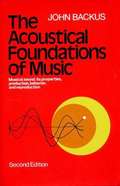- Table View
- List View
Acoustic Emission Testing: Basics for Research – Applications in Engineering (Springer Tracts in Civil Engineering)
by Christian U. Grosse Masayasu Ohtsu Dimitrios G. Aggelis Tomoki ShiotaniThis book provides an introduction to Acoustic Emission Testing and its applications to different materials like concrete, steel, ceramics, geotechnical materials, polymers, biological structures and wood. Acoustic Emission Techniques (AET) techniques have been studied in engineering for a long time. The techniques are applied more and more to practical investigations and are more and more standardized in codes. This is because the degradation of structures due to ageing urgently demand for maintenance and rehabilitation of structures in service. It results in the need for the development of advanced and efficient inspection techniques. In mechanical engineering and concerning the monitoring of machines and mechanical components, AE is a widely accepted observing deterioration in the frame of structural health monitoring. The advantages of AE like sensitivity, damage localization potential, non-intrusive nature as well as developments in signal analysis and data transmission allow applications that could not be considered decades ago.As such, AE techniques draw great attention to diagnostic applications and in material testing. This book covers all levels from the description of AE basics for AE beginners (level of a student) to sophisticated AE algorithms and applications to real large-scale structures as well as the observation of the cracking process in laboratory specimen to study fracture processes. This book has proved its worth over the past twelve years. Now in its second edition, it will be a resource that sets the standard and equips readers for the future. All chapters from the 1st edition have been updated and rewritten and eight extra chapters (e.g also regarding AE tomography, AE in plate-like structures and AE for investigations of hardening of fresh concrete) have been added.
The Acoustic Environment of Care Homes: Case Studies from China
by Jingyi Mu Jian KangThis book examines the indoor acoustic environment of China's care homes. Chapter 1 provides a brief introduction to the current situation in China's care homes. This includes the distribution, size, demand, and future development direction of these facilities. The chapter then presents an in-depth introduction and analysis of the indoor environment of these facilities, especially the acoustic environment. In Chapter 2, a case study and site investigation are described, and these are used to analyse the current state of the acoustic environment in these facilities, including the sound pressure level (SPL) and reverberation time (RT). Chapter 3 details the perceptions of the elderly regarding the acoustic environment of care homes and the correlation between the sound environment and other physical environments at the facilities. Chapter 4 presents the impact of the acoustic environment on the well-being of elderly residents and an analysis of the effects of different sound sources on the activities of the elderly. The effects of the acoustic environment on physiological indices of the elderly under different sound sources in care homes are analysed in Chapter 5. Finally, in Chapter 6, certain improvement strategies for the indoor acoustic environment of care homes are proposed based on the analysis. This book is a comprehensive exposition of research on the acoustic environment of care homes in China, and is useful reading for researchers in acoustics, architecture, design, engineering, and healthcare facilities. It could also be used as a scientific introduction for readers interested in this field.
Acoustic Fish Reconnaissance
by I.L. Kalikhman K. I. YudanovUntil now, there has not been any work that systematically presents the subject of acoustic fish reconnaissance, details all major aspects of applying acoustic equipment in commercial fish reconnaissance, and offers sufficient analysis of the effectiveness of fish-finding techniques. Acoustic Fish Reconnaissance responds to this need by providing t
Acoustic Guitar Design
by Richard Mark FrenchThis book is for experienced luthiers and guitar designers in the industry, novice builders wishing to improve their designs, and guitar owners interested in knowing more about their instruments. It includes the most important technical information gathered from many sources, including the academic literature and the author’s own work, presented here in a clear, actionable form with a minimum of mathematics. The book begins with a historical survey on how important features of the acoustic guitar evolved over centuries. The review leads up to a chapter focusing on three iconic instruments that represent the most important types of acoustic guitars: classical, steel string flat top and archtop. As the guitar market is so strongly conditioned by familiar, traditional instruments, a successful builder must have a thorough working understanding of the most important designs to underpin their own work. Through this volume, Professor French lays out the entire design process and collects detailed information in one convenient source. Luthiers quite often compile notebooks of measurements, part numbers, specific design features and other details they routinely need. This book organizes much of that information, with tables of dimensions, material properties, and other details in one essential final chapter. The book also features concise side bar contributions by top guitar designers and builders including Tim Shaw, Chief Engineer at Fender Music; Bob Taylor, Co-Founder of Taylor Guitars; and Andy Powers, Master Guitar Designer and Partner.
Acoustic Guitar Styles
by Larry Sandberg"Acoustic Guitar Styles" introduces the most popular traditional styles for the acoustic guitar. The step-by-step approach, using a small repertoire of well-known songs, enables the student to explore various styles that can be adapted to play personal favorites. Although a basic knowledge of the guitar is assumed, even the beginner will benefit from this progressive approach.
Acoustic Interculturalism
by Marcus Cheng Chye TanAcoustic Interculturalism is a study of the soundscapes of intercultural performance through the examination of sound's performativity. Employing an interdisciplinary approach, the book examines an akoumenological reception of sound to postulate the need for an acoustic knowing - an awareness of how sound shapes the intercultural experience.
Acoustic Investigation of Complex Seabeds (SpringerBriefs in Oceanography)
by Jacques Yves Guigné Philippe BlondelOffshore drilling and constructions require exact knowledge of the geophysical properties of the seabed and sub-seabed, as unexpected objects can slow down or halt projects. This book presents the state-of-the-art in acoustic exploration of the seabed and sub-seabed, from initial designs in the 1980s to commercial contracting and operation of the Acoustic Corer(tm) in the last decade. The Acoustic Corer(tm) is a high-definition commercial acoustic sub-bottom imaging system, producing an "acoustic core" within which sub-seabed sedimentary characteristics and discrete buried objects larger than 0. 5 m can be identified and mapped. It makes use of the innovative JYG-cross design, inspired by seismic reflection and uses Synthetic Aperture Sonar (SAS) multi-angle scattering in and within the seabed to deliver unprecedented imagery. This book was written by the inventor of these concepts, a known specialist in seabed acoustics, with help from an experienced academic and author. It is intended first and foremost as a "how-to" guide for offshore industries looking at techniques to make the installation of different types of structures safe and efficient.
Acoustic Invisibility for Elliptic Objects: Theory and Experiments for Underwater Sound (SpringerBriefs in Applied Sciences and Technology Series)
by Davide Enrico Quadrelli Francesco BraghinThe book investigates acoustic cloaking for elliptical targets, starting from the development of a systematic approach to deal with such non-axisymmetrical shapes by adopting transformation acoustics in elliptic coordinates, and concluding with numerical and experimental validation of a microstructured cloak in the underwater environment. The book thus comprises all the steps from theory to practice that led to the first experimental validation of acoustic invisibility for non-cylindrical objects, whose results are presented in the last chapter. Indeed, despite Transformation Theory is now an established tool to design material distributions capable to unlock the design of invisibility devices, it is not trivial to apply it for shapes different than the sphere and the cylinder, which are thus the ones mainly addressed in the literature. This book paves the way for exploration of other shapes, demonstrating the effectiveness of a pentamode cloak in reducing the acoustic visibility of an elliptical target, and discussing design choices that can make the implementation of the required microstructure less cumbersome despite the lack of axial symmetry of the problem, from both the numerical and manufacturing point of views.
Acoustic Invisibility for Elliptic Objects: Theory and Experiments for Underwater Sound (SpringerBriefs in Applied Sciences and Technology)
by Davide Enrico Quadrelli Francesco BraghinThe book investigates acoustic cloaking for elliptical targets, starting from the development of a systematic approach to deal with such non-axisymmetrical shapes by adopting transformation acoustics in elliptic coordinates, and concluding with numerical and experimental validation of a microstructured cloak in the underwater environment. The book thus comprises all the steps from theory to practice that led to the first experimental validation of acoustic invisibility for non-cylindrical objects, whose results are presented in the last chapter. Indeed, despite Transformation Theory is now an established tool to design material distributions capable to unlock the design of invisibility devices, it is not trivial to apply it for shapes different than the sphere and the cylinder, which are thus the ones mainly addressed in the literature. This book paves the way for exploration of other shapes, demonstrating the effectiveness of a pentamode cloak in reducing the acoustic visibility of an elliptical target, and discussing design choices that can make the implementation of the required microstructure less cumbersome despite the lack of axial symmetry of the problem, from both the numerical and manufacturing point of views.
Acoustic Levitation: From Physics to Applications
by Duyang ZangThis book systematically introduces readers to the fundamental physics and a broad range of applications of acoustic levitation, one of the most promising techniques for the container-free handling of small solid particles and liquid droplets. As it does away with the need for solid walls and can easily be incorporated into analysis instruments, acoustic levitation has attracted considerable research interest in many fields, from fluid physics to material science. The book offers a comprehensive overview of acoustic levitation, including the history of acoustic radiation force; the design and development of acoustic levitators; the technology’s applications, ranging from drop dynamics studies to bio/chemical analysis; and the insightful perspectives that the technique provides. It also discusses the latest advances in the field, from experiments to numerical simulations. As such, the book provides readers with a clearer understanding of acoustic levitation, while also stimulating new research areas for scientists and engineers in physics, chemistry, biology, medicine and other related fields.
Acoustic Levitation-Based Trace-Level Biosensing: Design of Detection Systems and Applications to Real Samples (Springer Theses)
by Akihisa MiyagawaThis book shows the availability and potential of the coupled acoustic-gravitational (CAG) field for trace-level biosensing. The proposed detection scheme also allows the evaluation of the kinetics and thermodynamics of the reaction occurring on a single microparticle (MP). This method has wide applicability in important fields, involving not only chemistry but also life, environmental, and medical sciences. The author proposes novel trace-level biosensing based on measurements of the levitation coordinate shift of an MP in the CAG field. The levitation coordinate of the MP in the CAG field is determined by its density and compressibility. The levitation coordinate shift is induced by the binding of gold nanoparticles (AuNPs) to the MP through interparticle reactions. Therefore, the quantity of molecules involved in the reaction can be determined from the levitation coordinate shift. The author demonstrates the zmol level detection for biotin, DNA/RNA, and organic molecules. In addition, the kinetics and thermodynamics are evaluated for various reactions occurring between the MP and AuNP, such as the avidin-biotin reaction, direct hybridization, sandwich hybridization, and aptamer-target complexation.This book provides a new concept based on the CAG field, in which the extent of a reaction is converted into the levitation coordinate shift, that is, “length.” The proposed method has many advantages over other methods, e.g., high biocompatibility, high applicability, and short analysis time. In addition, because the apparatus used in this study is inexpensive and easy to miniaturize, this method is useful in important practical fields, such as forensic and environmental science and diagnosis. Thus, this book inspires many researchers to apply the present method to their own fields of interest.
Acoustic Metamaterials: Absorption, Cloaking, Imaging, Time-Modulated Media, and Topological Crystals (Springer Series in Materials Science #345)
by Richard Craster Sébastien GuenneauThe revised edition of this book offers an expanded review of acoustic metamaterials; novel materials which can manipulate sound waves, surface Rayleigh waves and water waves, in surprising ways, which include collimation, focusing, negative refraction, passive and active cloaking, sonic screening and extraordinary transmission. It covers both experimental and theoretical aspects of acoustic and elastic waves propagating in structured composites, with a focus on effective properties associated with negative refraction, lensing and cloaking. Updated chapters cover filtering effects, extraordinary transmission, sub-wavelength imaging via tomography or time-reversal techniques, cloaking via transformation acoustics, elastodynamics, and acoustic scattering cancellation. For this revised edition, six new chapters have been introduced to reflect recent developments in experimental acoustics and metasurfaces including acoustic impedance gratings and mirror symmetric metamaterials, phononic subsurfaces, time-modulated and topological crystals. The latter two are illustrated by simple Python program examples. The broad scope gives the reader an overview of the state of the art in acoustic metamaterials research and an indication of future directions and applications. It will serve as a solid introduction to the field for advanced students and researchers in physics, applied mathematics and mechanical engineering, and a valuable reference for those working in metamaterials and related areas.
Acoustic Metamaterials: Negative Refraction, Imaging, Lensing and Cloaking (Springer Series in Materials Science #166)
by Richard V. Craster Sébastien GuenneauAbout the book: This book is the first comprehensive review on acoustic metamaterials; novel materials which can manipulate sound waves in surprising ways, which include collimation, focusing, cloaking, sonic screening and extraordinary transmission. It covers both experimental and theoretical aspects of acoustic and elastic waves propagating in structured composites, with a focus on effective properties associated with negative refraction, lensing and cloaking. Most related books in the field address electromagnetic metamaterials and focus on numerical methods, and little (or no) experimental section. Each chapter will be authored by an acknowledged expert, amongst the topics covered will be experimental results on non-destructive imaging, cloaking by surface water waves, flexural waves in thin plates. Applications in medical ultrasound imaging and modeling of metamaterials will be emphasized too. The book can serve as a reference for researchers who wish to build a solid foundation of wave propagation in this class of novel materials.
Acoustic Metamaterials and Phononic Crystals (Springer Series in Solid-State Sciences #173)
by Pierre A. DeymierThis comprehensive book presents all aspects of acoustic metamaterials and phononic crystals. The emphasis is on acoustic wave propagation phenomena at interfaces such as refraction, especially unusual refractive properties and negative refraction. A thorough discussion of the mechanisms leading to such refractive phenomena includes local resonances in metamaterials and scattering in phononic crystals.
Acoustic Modeling for Emotion Recognition (SpringerBriefs in Speech Technology)
by Koteswara Rao Anne Swarna Kuchibhotla Hima Deepthi VankayalapatiThis book presents state of art research in speech emotion recognition. Readers are first presented with basic research and applications - gradually more advance information is provided, giving readers comprehensive guidance for classify emotions through speech. Simulated databases are used and results extensively compared, with the features and the algorithms implemented using MATLAB. Various emotion recognition models like Linear Discriminant Analysis (LDA), Regularized Discriminant Analysis (RDA), Support Vector Machines (SVM) and K-Nearest neighbor (KNN) and are explored in detail using prosody and spectral features, and feature fusion techniques.
Acoustic Particle Velocity Measurements Using Lasers: Principles, Signal Processing and Applications
by Jean-Christophe ValièreThis book concerns the presentation of particle velocity measurement for acoustics using lasers, including Laser Doppler Velocimetry (LDV or Anemometry (LDA)) and Particle Imagery Velocimetry (PIV).The objective is first to present the importance of measuring the acoustic velocity, especially when the acoustic equations are nonlinear as well as characterizing the near fields. However, these applications need to use non-invasive sensors. Some optical techniques, initially developed for fluid mechanics, have been adapted to the field of acoustics in recent years. This book summarizes 15 years of research in this area, highlighting the improvements that have been made, particularly in signal processing, and showing applications for which they have proven to be a carrier of innovation.
The Acoustic Self in English Modernism and Beyond: Writing Musically
by Zoltan VargaDrawing on the analogy between musical meaning-making and human subjectivity, this book develops the concept of the acoustic self, exploring the ways in which musical characterization and structure are related to issues of subject-representation in the modernist English novel. The volume is framed around three musical topics—the fugue, absolute music, and Gesamtkunstwerk—arguing that these three modes of musicalization address modernist dilemmas around selfhood and identity. Varga reflects on the manifestations of the acoustic self in examples from the works of E.M. Forster, Aldous Huxley, and Virginia Woolf, and such musicians as Bach, Beethoven, Handel, and Wagner. An additional chapter on jazz and electronic music supplements these inquiries, pursuing the acoustic self beyond modernism and thereby inciting further discussion and theorization of musical intermediality, as well as recent sonic practices. Probing the analogies in the complex interrelationship between music, representation, and language in fictional texts and the nature of human subjectivity, this book will appeal to students and scholars interested in the interface of language and music, in such areas as intermediality, multimodality, literary studies, critical theory, and modernist studies.
Acoustic Sensors for Biomedical Applications (SpringerBriefs in Speech Technology)
by Nilanjan Dey Amira S. Ashour Waleed S. Mohamed Nhu Gia NguyenIn this book, application-related studies for acoustic biomedical sensors are covered in depth. The book features an array of different biomedical signals, including acoustic biomedical signals as well as the thermal biomedical signals, magnetic biomedical signals, and optical biomedical signals to support healthcare. It employs signal processing approaches, such as filtering, Fourier transform, spectral estimation, and wavelet transform. The book presents applications of acoustic biomedical sensors and bio-signal processing for prediction, detection, and monitoring of some diseases from the phonocardiogram (PCG) signal analysis. Several challenges and future perspectives related to the acoustic sensors applications are highlighted. This book supports the engineers, researchers, designers, and physicians in several interdisciplinary domains that support healthcare.
Acoustic Technologies in Biology and Medicine
by Adem Ozcelik Ryan Becker Tony Jun HuangAcoustic Technologies in Biology and Medicine Complete, balanced resource encompassing all required technical, theoretical, and applied multidisciplinary knowledge related to acoustics Taking a multidisciplinary approach involving fluid mechanics, physics, chemistry, electronics, and the life sciences to provide a unified and competent overview of the field, Acoustic Technologies in Biology and Medicine covers the fundamental principles of acoustic wave generation and propagation, different acoustic systems and technologies with the interplay of physical forces, theoretical foundations, and the state-of-the-art biomedical applications of acoustics. State-of-the-art applications of acoustics in biology and medicine are presented, including single cell and organism manipulation, acoustic biosensing, cancer cell isolation (liquid biopsy), cell/tissue stimulation and ablation, micro-robot actuation, acoustic imaging, and drug delivery. Contributed to and edited by highly qualified professionals with significant experience in the field, Acoustic Technologies in Biology and Medicine covers sample topics such as: Materials for acoustic wave generation and modulation, ultrasound imaging, and photoacoustic imaging and sensing for biomedical applications Therapeutic ultrasound, application of ultrasound responsive reagents for drug delivery systems, and acoustic levitation and acoustic holograms Application of ultrasonic waves in bioparticle manipulation and separation, acoustic biosensors, and acoustic micro and nanorobots in medicine Different technologies of acoustic systems, including bulk and surface acoustic wave-based platforms, acoustic imaging, acoustic sensors, and acoustic levitators A cornerstone reference bridging the gap between rapidly advancing acoustic technologies with state-of-the-art applications in biology and medicine, Acoustic Technologies in Biology and Medicine is an essential resource on the subject for biophysicists, materials scientists, biotechnologists, bioengineers, sensor developers, electronics engineers, and all professionals in the greater biotechnological industry.
Acoustic Textiles (Textile Science and Clothing Technology)
by Rajiv Padhye Rajkishore NayakThis book highlights the manufacturing and applications of acoustic textiles in various industries. It also includes examples from different industries in which acoustic textiles can be used to absorb noise and help reduce the impact of noise at the workplace. Given the importance of noise reduction in the working environment in several industries, the book offers a valuable guide for companies, educators and researchers involved with acoustic materials.
Acoustic Waves Generated by Parametric Array Loudspeakers
by Xiaojun Qiu Jiaxin ZhongParametric array loudspeakers (PALs) are capable of generating highly directional audio beams from nonlinear interactions of intense airborne ultrasound waves. This unique capability holds great potential in audio engineering. This book systematically introduces the physical principles of acoustics waves generated by PALs, along with the commonly used and the state-of-the-art numerical models, such as the Westervelt model, the convolution directivity model, the Gaussian beam expansion method, and the spherical wave expansion method.The properties of sound fields generated by PALs are analyzed. Also analyzed are various phenomena including the reflection of acoustics waves generated by PALs from a surface, transmission through a thin partition, scattering by a rigid sphere, and propagation in rooms. Furthermore, the steering and focusing of acoustics waves generated by PALs and potential applications of PALs in active sound control are investigated. Finally, the implementation issues of hardware, signal processing techniques, measurement, and safety are discussed.The book is tailored to meet the needs of researchers in this field, as well as audio practitioners and acoustics engineers.
Acoustic Waves in Boreholes
by Frederick L. Paillet Chuen Hon ChengIntroducing the first, self-contained reference on acoustic waveform loggingAcoustic measurements in boreholes were first made as a specialized logging technique in geological exploration, but recent advances have greatly expanded the potential applications of this technique. Acoustic Waves in Boreholes provides a thorough review of the theory and interpretation techniques needed to realize these applications, emphasizing the role of guided modes and critically refracted waves in determining the characteristics of recorded waveforms. Topics covered in this comprehensive volume include the seismic properties of rocks; propagation of axisymmetric waves along fluid-filled boreholes in isotropic rocks; and symmetric and nonsymmetric sources in isotropic, transversely isotropic, and porous, permeable formations in open and cased boreholes. Each chapter includes the theory of synthetic microseismogram computation, interpretation and data inversion techniques illustrated using computed seismograms, and case histories using experimental data. Appendices providing the mathematical formulation needed to compute microseismograms, with a single consistent notation used throughout, are also included in appropriate chapters.The wide range of geomechanical properties covered in this book will interest exploration geophysicists, reservoir engineers, civil engineers, geologists, and soil scientists.
Acoustic Waves in Periodic Structures, Metamaterials, and Porous Media: From Fundamentals to Industrial Applications (Topics in Applied Physics #143)
by Noé Jiménez Olga Umnova Jean-Philippe GrobyThis book delivers a comprehensive and up-to-date treatment of practical applications of metamaterials, structured media, and conventional porous materials. With increasing levels of urbanization, a growing demand for motorized transport, and inefficient urban planning, environmental noise exposure is rapidly becoming a pressing societal and health concern. Phononic and sonic crystals, acoustic metamaterials, and metasurfaces can revolutionize noise and vibration control and, in many cases, replace traditional porous materials for these applications.In this collection of contributed chapters, a group of international researchers reviews the essentials of acoustic wave propagation in metamaterials and porous absorbers with viscothermal losses, as well as the most recent advances in the design of acoustic metamaterial absorbers. The book features a detailed theoretical introduction describing commonly used modelling techniques such as plane wave expansion, multiple scattering theory, and the transfer matrix method. The following chapters give a detailed consideration of acoustic wave propagation in viscothermal fluids and porous media, and the extension of this theory to non-local models for fluid saturated metamaterials, along with a description of the relevant numerical methods. Finally, the book reviews a range of practical industrial applications, making it especially attractive as a white book targeted at the building, automotive, and aeronautic industries.
Acoustical Analysis of the Tanpura: Indian Plucked String Instrument (Signals and Communication Technology)
by Asoke Kumar Datta Ranjan Sengupta Kaushik Banerjee Dipak GhoshThis book addresses the acoustic signal analysis and spectral dynamics of the tanpura, an Indian plucked string instrument. In addition, it strives to provide a logical and objective explanation of Indian classical musicians’ cognitive experience. Issues of relevance in this regard include the rich, mellifluous sound; the undulation of the loudness; the somewhat cyclical variation of the timbre, which is strongly related to these undulations; and the occasional perception of virtual notes to which no strings are tuned. The book analyses the materials used in the tanpura, the instrument’s simple structure, the intricacies of the lower bridge, and the theory of string vibration with variable string length. Cognitive experiments to provide the basis for perceptual quality assessment, as well as a methodology for ranking, are described. This is followed by acoustic analyses, both temporal and spectral, for sounds produced by male and female tanpuras, for each individual string and the combined one. An important aspect related to the naturalness of perceived sound, namely the intrinsically associated random perturbations, is also discussed. The apparent irregularities perceived in the acoustic signal produced by the tanpura reveal the importance of examining the signal from the perspective of non-linear analysis, an aspect that is also covered in the book. Given its scope, the book will appeal to students and researchers in the fields of music acoustics, artificial intelligence, and cognitive science, as well as musicians and musicologists around the world.
The Acoustical Foundations of Music (2nd edition)
by John BackusThe original purpose of Professor Backus's book was to collect and organize the scattered results of research, past and present, in the areas of scientific knowledge that are relevant to music: the physiological properties of sounds; the effect of acoustical environment; the acoustical behavior of musical instruments; and the various applications of electronics and computers to the production, reproduction, and composition of music. The aims and organization of the second edition remain the same; the results are more complete and up-to-date.
